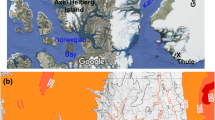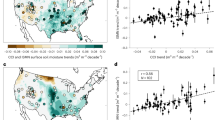Abstract
The energy, momentum and mass exchanges between the soil and the atmosphere take place in the surface layer. The difference between the screen temperature of the air at 2 m (T2) and the land surface temperature (LST) is a key parameter in their determination. Here an analysis of this difference is made with data from a site at the island of Mallorca, in the Western Mediterranean. While previous studies are often built for relatively short temporal intervals (from several days to few months), the current work analyzes 2-year-long series with a 30 min temporal resolution, in particular the diurnal and seasonal variability. The uncertainty of LST measured from near the ground is estimated to be at least 2 \(^{\circ }\)C. The difference between T2 and LST (T2–LST) in the center of the day ranges between − 3 and − 10 \(^{\circ }\)C, arriving at about − 18 \(^{\circ }\)C for dry summer days. Statistically it is shown that these values are related to the net radiation heating of the surface transmitted upwards by thermal turbulence. The values in summer are much larger because the upper dry soil does not allow the heat to be transmitted efficiently into the ground. At night T2–LST is usually under 3 \(^{\circ }\)C, with weak correlations of T2–LST with net radiation or ground flux, indicating that these processes are active and efficient transporting heat in most cases. The better correlated quantities at night with T2–LST are the upper soil temperature, the LST and the turbulent heat flux, reflecting the importance of the state of the surface. In summer nights T2–LST takes very small values, below 1 \(^{\circ }\)C, even allowing unstable stratification. This is a result of a soil in which the first centimeters are very warm after sunset, not being able to send heat into the dry soil and releasing it into the atmosphere.

Source: Google Earth






Similar content being viewed by others
References
Anderson, M. C., Allen, R. G., Morse, A., & Kustas, W. P. (2012). Use of landsat thermal imagery in monitoring evapotranspiration and managing water resources. Remote Sensing of Environment, 122, 50–65.
Aubinet, A., Vesala, T., & Papale, D. (Eds.). (2012). Eddy covariance: A practical guide to measurement and data analysis. Springer atmospheric sciences. Berlin: Springer.
Blonquist, J., Tanner, B., & Bugbee, B. (2009). Evaluation of measurement accuracy and comparison of two new and three traditional net radiometers. Agricultural and Forest Meteorology, 149(10), 1709–1721.
Brutsaert, W. (1975). On a derivable formula for long-wave radiation from clear skies. Water Resources Research, 11(5), 742–744.
Coll, C., Caselles, V., Galve, J. M., Valor, E., Niclós, R., Sánchez, J. M., et al. (2005). Ground measurements for the validation of land surface temperatures derived from aatsr and modis data. Remote Sensing of Environment, 97(3), 288–300.
Coll, C., García-Santos, V., Niclòs, R., & Caselles, V. (2016). Test of the modis land surface temperature and emissivity separation algorithm with ground measurements over a rice paddy. IEEE Transactions on Geoscience and Remote Sensing, 54, 3061–3069.
Cuxart, J., Conangla, L., & Jiménez, M. A. (2015). Evaluation of the surface energy budget equation with experimental data and the ECMWF model in the Ebro Valley. Journal of Geophysical Research Atmospheres, 120, 1008–1022.
Cuxart, J., Jiménez, M. A., & Martínez, D. (2007). Nocturnal meso-beta basin and katabatic flows on a midlatitude island. Monthly Weather Review, 135, 918–932.
Cuxart, J., Jiménez, M. A., Telisman-Prtenjak, M., & Grisogono, B. (2014). Study of a sea-breeze case through momentum, temperature, and turbulence budgets. Journal of Applied Meteorology and Climatology, 53, 2589–2609.
Data, C. (2009). Guidelines on analysis of extremes in a changing climate in support of informed decisions for adaptation. World Meteorological Organization.
Ermida, S. L., Trigo, I. F., DaCamara, C. C., Göttsche, F. M., Olesen, F. S., & Hulley, G. (2014). Validation of remotely sensed surface temperature over an oak woodland landscape. The problem of viewing and illumination geometries. Remote Sensing of Environment, 148, 16–27.
Foken, T. (2008). Micrometeorology (p. 308). Heidelberg: Springer.
Göttsche, F. M., Olesen, F. S., & Bork-Unkelbach, A. (2013). Validation of land surface temperature derived from MSG/SEVIRI with in situ measurements at Gobabeb, Namibia. International Journal of Remote Sensing, 34(9–10), 3069–3083.
Jiménez, M. A., Mira, A., Cuxart, J., Luque, A., Alonso, S., & Guijarro, J. A. (2008). Verification of a clear-sky mesoscale simulation using satellite—derived surface temperatures. Monthly Weather Review, 136, 5148–5161.
Jiménez, M. A., Ruiz, A., & Cuxart, J. (2015). Estimation of cold pool areas and chilling hours through satellite—derived surface temperatures. Agricultural and Forest Meteorology, 207, 58–68.
Jin, M., & Dickinson, R. E. (2010). Land surface skin temperature climatology: Benefitting from the strengths of satellite observations. Environmental Research Letters, 5, 044,004.
Kalma, J. D., McVicar, T. R., & McCabe, M. F. (2008). Estimating land surface evaporation: A review of methods using remotely sensed surface temperature data. Surveys in Geophysics, 29(4–5), 421–469.
Kondratyev, K. Y. (1969). (Vol. 19692) New York.
Krishnan, P., Kochendorfer, J., Dumas, E. J., Guillevic, P. C., Baker, C. B., Meyers, T. P., et al. (2015). Comparison of in-situ, aircraft, and satellite land surface temperature measurements over a noaa climate reference network site. Remote Sensing of Environment, 165, 249–264.
Kustas, W., & Norman, J. (1996). Use of remote sensing for evapotranspiration monitoring over land surfaces. Hydrological Sciences Journal, 41(4), 495–516.
Kustas, W., Norman, J., Hain, C., Mecikalski, J., Schultz, L., González-Dugo, M., et al. (2011). Mapping daily evapotranspiration at field to continental scales using geostationary and polar orbiting satellite imagery. Hydrology and Earth System Sciences, 15(1), 223.
Li, Z. L., & Becker, F. (1993). Feasibility of land surface temperature and emissivity determination from AVHRR data. Remote Sensing of Environment, 43(1), 67–85.
Li, F., Jackson, T. J., Kustas, W. P., Schmugge, T. J., French, A. N., Cosh, M. H., et al. (2004). Deriving land surface temperature from landsat 5 and 7 during smex02/smacex. Remote Sensing of Environment, 92(4), 521–534.
Liou, K. N. (2002). An introduction to atmospheric radiation (Vol. 84). London: Academic Press.
Li, Z. L., Tang, B. H., Wu, H., Ren, H., Yan, G., Wan, Z., et al. (2013). Satellite-derived land surface temperature: Current status and perspectives. Remote Sensing of Environment, 131, 14–37.
Mannstein, H.: Surface energy budget, surface temperature and thermal inertia. In Remote sensing applications in meteorology and climatology (pp. 391–410). Berlin: Springer (1987).
Martí, B., Martínez-Villagrasa, D., & Cuxart, J.: Nocturnal fine structure of the temperature column between 2 and -0.1 m. In: EMS annual meeting abstracts, vol. 13. Trieste, Italy (2016).
Mildrexler, D. J., Zhao, M., & Running, S. W. (2011). A global comparison between station air temperatures and MODIs land surface temperatures reveals the cooling role of forests. Journal of Geophysical Research Biogeosciences, 116, 3.
Mintz, Y., & Walker, G. (1993). Global fields of soil moisture and land surface evapotranspiration derived from observed precipitation and surface air temperature. Journal of Applied Meteorology, 32(8), 1305–1334.
Niclòs, R., Estrela, M., Valiente, J., & Barberà, M. (2010). Análisis de correlaciones entre la temperatura del aire y la temperatura de las superficies vegetadas medida con radiometría térmica (regression analysis between air temperature and vegetated-surface temperature measured by thermal radiometry). Rev Teledetección, 34, 36–43.
Niclòs, R., Valiente, J. A., Barberà, M. J., & Coll, C. (2015). An autonomous system to take angular thermal—infrared measurements for validating satellite products. Remote Sensing, 7(11), 15269–15294.
Noilhan, J., & Planton, S. (1989). A simple parameterization of land surface processes for meteorological models. Monthly Weather Review, 117, 536–549.
Pape, R., & Löffler, J. (2004). Modelling spatio-temporal near-surface temperature variation in high mountain landscapes. Ecological Modelling, 178(3), 483–501.
Peres, L. F., & DaCamara, C. C. (2004). Land surface temperature and emissivity estimation based on the two-temperature method: Sensitivity analysis using simulated msg/seviri data. Remote Sensing of Environment, 91(3), 377–389.
Plokhenko, Y., & Menzel, W. P. (2000). The effects of surface reflection on estimating the vertical temperature-humidity distribution from spectral infrared measurements. Journal of Applied Meteorology, 39(1), 3–14.
Prihodko, L., & Goward, S. N. (1997). Estimation of air temperature from remotely sensed surface observations. Remote Sensing of Environment, 60(3), 335–346.
Schmugge, T.J., & Becker, F.: Remote sensing observations for the monitoring of land-surface fluxes and water budgets. In Land surface evaporation (pp. 337–347). Springer (1991).
Schotanus, P., Nieuwstadt, F., & De Bruin, H. (1983). Temperature measurement with a sonic anemometer and its application to heat and moisture fluxes. Boundary-Layer Meteorology, 26(1), 81–93.
Sellers, P. J., Dickinson, R. E., Randall, D. A., Betts, A. K., Hall, F. G., Berry, J. A., et al. (1997). Modeling the exchanges of energy, water, and carbon between continents and the atmosphere. Science, 275(5299), 502–509.
Sellers, P., Hall, F., Asrar, G., Strebel, D., & Murphy, R. (1988). The first islscp field experiment (FIFE). Bulletin of the American Meteorological Society, 69(1), 22–27.
Shamir, E., & Georgakakos, K. P. (2014). Modis land surface temperature as an index of surface air temperature for operational snowpack estimation. Remote Sensing of Environment, 152, 83–98.
Simó, G., García-Santos, V., Jiménez, M. A., Martínez-Villagrasa, D., Picos, R., Caselles, V., et al. (2016). Landsat and local land surface temperatures in a heterogeneous terrain compared to MODIs values. Remote Sensing, 8(10), 849.
Snyder, W. C., Wan, Z., Zhang, Y., & Feng, Y. Z. (1998). Classification-based emissivity for land surface temperature measurement from space. Journal of Remote Sensing, 19(14), 2753–2774.
Stull, R. B. (1988). An introduction to boundary layer meteorology. The Netherlands: Springer.
Tierney, J. E., Russell, J. M., Huang, Y., Damsté, J. S. S., Hopmans, E. C., & Cohen, A. S. (2008). Northern hemisphere controls on tropical southeast African climate during the past 60,000 years. Science, 322(5899), 252–255.
Vancutsem, C., Ceccato, P., Dinku, T., & Connor, S. J. (2010). Evaluation of MODIs land surface temperature data to estimate air temperature in different ecosystems over Africa. Remote Sensing of Environment, 114(2), 449–465.
Vogt, J. V., Viau, A. A., & Paquet, F. (1997). Mapping regional air temperature fields using satellite-derived surface skin temperatures. International Journal of Climatology, 17(14), 1559–1579.
Wan, Z., Wang, P., & Li, X. (2004). Using modis land surface temperature and normalized difference vegetation index products for monitoring drought in the southern great plains, USA. International Journal of Remote Sensing, 25(1), 61–72.
Yu, W., & Ma, M. (2015). Scale mismatch between in situ and remote sensing observations of land surface temperature: Implications for the validation of remote sensing LST products. Geoscience and Remote Sensing Letters IEEE, 12(3), 497–501.
Zhang, Y. C., Rossow, W., & Lacis, A. (1995). Calculation of surface and top of atmosphere radiative fluxes from physical quantities based on ISCCP data sets: 1 method and sensitivity to input data uncertainties. Journal of Geophysical Research Atmospheres, 100(D1), 1149–1165.
Zhou, J., Zhang, X., Zhan, W., & Zhang, H. (2014). Land surface temperature retrieval from MODIs data by integrating regression models and the genetic algorithm in an arid region. Remote Sensing, 6(6), 5344–5367.
Acknowledgements
Funding through the project CGL2015-65627-C3-1-R (MINECO/FEDER) of the Spanish Government, supplied by the European Regional Development Fund (FEDER). G. Simó is funded by the FPI-Grant BES-2013-065290. The authors would like to thank two anonymous reviewers for providing very useful comments that have contributed to the improvement of the paper.
Author information
Authors and Affiliations
Corresponding author
Rights and permissions
About this article
Cite this article
Simó, G., Martínez-Villagrasa, D., Jiménez, M.A. et al. Impact of the Surface–Atmosphere Variables on the Relation Between Air and Land Surface Temperatures. Pure Appl. Geophys. 175, 3939–3953 (2018). https://doi.org/10.1007/s00024-018-1930-x
Received:
Revised:
Accepted:
Published:
Issue Date:
DOI: https://doi.org/10.1007/s00024-018-1930-x




